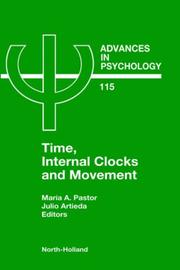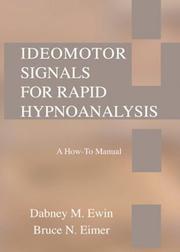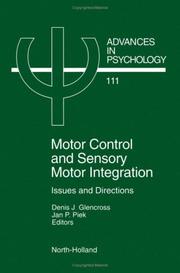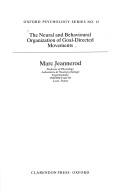
ISBN: 9780444821140 0444821147 9780080543048 0080543049 1281055271 9786611055271 Year: 1996 Publisher: Amsterdam ; New York : Elsevier,
Abstract | Keywords | Export | Availability | Bookmark
 Loading...
Loading...Choose an application
- Reference Manager
- EndNote
- RefWorks (Direct export to RefWorks)
Interest in the concept of time has a long history and has been a topic of study for a wide range of investigators. No change can take place without specification of time. While philosophers and physicists have been intrigued by the concept of subjective perception of time and its relationship to real time, natural scientists have been concerned mainly with investigating time as a factor in understanding the behaviour of animals from the migratory habits of birds to the periodical breeding cycles. The immense bulk of temporal perception studies, the variety of approaches, methods of measuremen
Movement, Psychology of --- Neuropsychology --- Perceptual-motor processes --- Time perception --- Experimentele psychologie --- Movement, Psychology of. --- Neuropsychology. --- Perceptual-motor processes. --- Time perception. --- perceptie en psychofysica.
Book
Year: 1967 Publisher: Amsterdam : North-Holland Pub. Co.,
Abstract | Keywords | Export | Availability | Bookmark
 Loading...
Loading...Choose an application
- Reference Manager
- EndNote
- RefWorks (Direct export to RefWorks)
Perceptual-motor processes --- Attention --- Performance --- Rendement au travail --- Congresses --- Congresses. --- Congrès
Book
ISBN: 3593338351 Year: 1987 Publisher: Frankfurt am Main ; New York : Campus,
Abstract | Keywords | Export | Availability | Bookmark
 Loading...
Loading...Choose an application
- Reference Manager
- EndNote
- RefWorks (Direct export to RefWorks)
Perception. --- Selectivity (Psychology) --- Perceptual-motor processes. --- Perception --- Sélectivité (Psychologie) --- Processus perceptivomoteurs
Periodical
Year: 1976 Publisher: [Novato, Calif.], [publisher not identified]
Abstract | Keywords | Export | Availability | Bookmark
 Loading...
Loading...Choose an application
- Reference Manager
- EndNote
- RefWorks (Direct export to RefWorks)
Somesthesia --- Perceptual-motor processes --- Psychophysiology --- Medicine, Psychosomatic --- Médecine psychosomatique. --- Philosophy. --- Psychosomatic Medicine.

ISBN: 0398084556 9780398084554 0398076286 9780398076283 0398076294 9780398076290 Year: 2006 Publisher: Springfield, Ill. Charles C Thomas
Abstract | Keywords | Export | Availability | Bookmark
 Loading...
Loading...Choose an application
- Reference Manager
- EndNote
- RefWorks (Direct export to RefWorks)
In today's managed mental health care environment, clinical hypnosis has become popular as a tool for alleviating symptoms promptly. This book is about using ideomotor (IM) signals in the rapid hypnoanalysis of psychosomatic disorders. The technique of rapid hypnoanalysis addresses the whole brain and places the feeling back into brief therapy without removing the logic or the efficiency. It offers a refreshing alternative that allows therapists to go deeper while being even briefer. Part I covers basic concepts and principles. The value, principles, and treatment planning of hypnoanalysis are
Hypnotism --- Perceptual-motor processes. --- Medicine, Psychosomatic. --- Mind and body. --- Therapeutic use.
Book
Year: 2015 Publisher: Frontiers Media SA
Abstract | Keywords | Export | Availability | Bookmark
 Loading...
Loading...Choose an application
- Reference Manager
- EndNote
- RefWorks (Direct export to RefWorks)
Autism Spectrum Disorders (ASD) are portrayed as cognitive and social disorders. Undoubtedly, impairments in communication and restricted-repetitive behaviors that define the disorders have a profound impact on social interactions. But can we go beyond the descriptive nature of this definition and objectively measure behavior? In this Research Topic we bring movement to the forefront of autism research, diagnosis, and treatment. We gather researchers across disciplines with the unifying goal of recognizing movement and sensory disturbances as core symptoms of the disorder. We will present evidence that profound movement and sensory differences exist in ASD that can be characterized in a way that is conducive with new behavioral treatments, an advantage over observational inventories. We will show that movement patterns can be used to identify sub-types of autism and to design target treatments tailored to each individual. We will show that, when utilizing motor behavior in conjunction with cognitive tasks, we can unveil the best sensory capabilities of each child as well as their unique predispositions to learn. Many individuals on the spectrum have been perceived as "non-verbal" because they do not speak. Yet, they can communicate through other means. In the absence of spoken language, movement research can open a door into sensorially-driven and gestural forms of communication. Movement can be used to amplify and modulate the sensory signal and help connect individuals with themselves and with their physical and social surroundings. Movement can help us evoke in each child the will to leave “the autistic bubble” and explore the world. We seek to standardize our measurements and definitions of movement abnormalities in autism relative to cognitive and social capabilities both at the individual level and within a social group. We will argue that movement, its sensation and its perception, will play a fundamental role in objectively measuring and standardizing autism: Its diagnosis, its treatment, and the tracking of an individual’s changes over time. We will redefine autism from the motor perspective—in closed loop with cognition—in such a way that cognitive and motor behaviors reshape each other to help evoke social awareness. While psychologists, psychiatrists, and cognitive scientists have provided an important conceptual framework to define the most obvious problems of the autistic behavior—those centered at the social and cognitive issues—we gather here occupational therapists, physical therapists, movement disorders specialists, the fellows in movement science, kinesiology and computational motor control, the pediatricians, and the teachers of children with ASD to focus on important sensory-motor differences that can be used to revise our definitions of ASD and unambiguously define its subtypes. We will move into action to go beyond subjective inferences to objectively understand real, physical behaviors using unprecedentedly fast and formal methods that can complement pencil-and-paper inventories. We will let the autistic body move and teach us what it feels, what it senses, and what it says. In turn, we will teach it to reach out into the world and seek communication. We will let those labeled “high-functioning” and “low-functioning” alike unlock their potential. We will use natural, physical motions to open new channels of sensorial and gestural communication. We will let movement play the transformative role that it can in broadening the spectrum of basic research in ASD to bring out the hidden inner voices of autism.
Autism. --- Autism --- Perceptual-motor processes. --- Sensory integration dysfunction. --- Research. --- outcome measures --- sensory motor --- Movement Disorders --- autism
Book
Year: 1961 Publisher: Groningen J.B. Wolters
Abstract | Keywords | Export | Availability | Bookmark
 Loading...
Loading...Choose an application
- Reference Manager
- EndNote
- RefWorks (Direct export to RefWorks)
Space perception --- Space perception in children --- Orientation (Psychology) --- Perceptual-motor processes
Book
ISBN: 9782807328105 2807328105 280734710X Year: 2020 Publisher: Louvain-la-Neuve: De Boeck supérieur,
Abstract | Keywords | Export | Availability | Bookmark
 Loading...
Loading...Choose an application
- Reference Manager
- EndNote
- RefWorks (Direct export to RefWorks)
Quatrième de couverture : "Au cours des premières années de vie, le bébé développe des postures stables et dynamiques dans les trois plans de l'espace. Ces plateformes sensori-toniques lui permettent d'explorer le monde qui l'entoure, d'intéragir avec le milieu humain et d'acquérir des compétences motrices et cognitives. Chaque enfant se développe à son rythme, selon son bagage génétique, sa maturation cérébrale, sa vitalité, sa motivation, son entourage, mais tous cherchent "des chemins", c'est-à-dire des trajectoires pour changer de position et acquérir des postres stables et dynamiques. Cette organisation du corps permet de libérer les "outils d'exploration" tels que la bouche, les yeux, les mains et les pieds, pour agir sur l'environnement."
Enfants --- Processus perceptivomoteurs. --- Développement de l'enfant. --- Développement. --- Child --- Child Development --- Nervous System --- Proprioception --- growth and development. --- Child development --- Perceptual-motor processes --- growth & development --- Child Development. --- Proprioception. --- growth & development. --- Perceptual-motor processes.

ISBN: 9780444819215 0444819215 9780080537009 0080537006 1280927194 9781280927195 9786610927197 6610927197 Year: 1995 Publisher: Amsterdam New York Elsevier
Abstract | Keywords | Export | Availability | Bookmark
 Loading...
Loading...Choose an application
- Reference Manager
- EndNote
- RefWorks (Direct export to RefWorks)
This volume evolved from a workshop which addressed the general area of motor control, and the broader problems of serial organisation and sensory-motor integration of human skills. A number of specific issues are highlighted, including the neural mechanisms and disabilities of sensory-motor integration, planning and programming of action, the dynamics of interlimb coordination, amendment and updating mechanisms, and in particular, perception-action coupling and the representation of action. Underlying much of the volume are the major theoretical issues which include the debate between computa
Sensorimotor integration. --- Perceptual-motor processes. --- Sensory-motor processes --- Movement, Psychology of --- Perception --- Integration, Sensorimotor --- Intersensory integration --- Perceptual-motor integration --- Sensimotor integration --- Sensory integration --- Sensory-motor integration --- Perceptual-motor processes --- Sensory integration dysfunction

ISBN: 0198521170 Year: 1988 Publisher: Oxford Clarendon
Abstract | Keywords | Export | Availability | Bookmark
 Loading...
Loading...Choose an application
- Reference Manager
- EndNote
- RefWorks (Direct export to RefWorks)
Motion perception (Vision) --- Movement, Psychology of --- Neuropsychology --- Perceptual-motor processes --- Goals --- Motor Activity --- Movement --- Nervous System Physiological Phenomena --- Neurophysiology

 Search
Search Feedback
Feedback About UniCat
About UniCat  Help
Help News
News